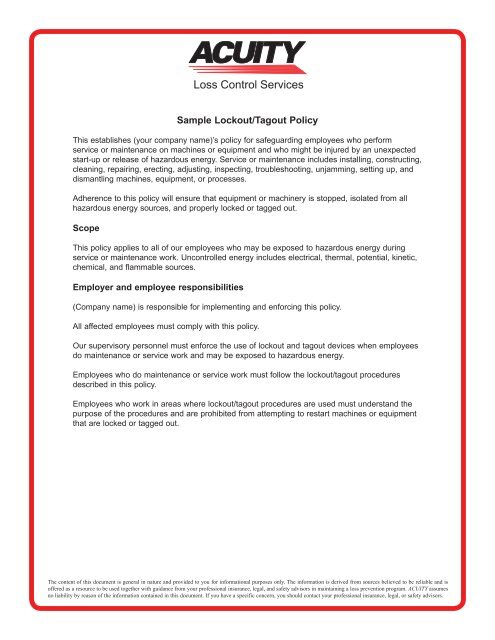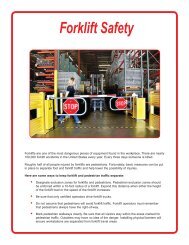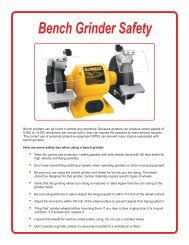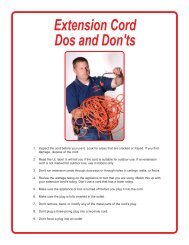Sample Lockout Tagout Policy.pdf - Acuity
Sample Lockout Tagout Policy.pdf - Acuity
Sample Lockout Tagout Policy.pdf - Acuity
Create successful ePaper yourself
Turn your PDF publications into a flip-book with our unique Google optimized e-Paper software.
Loss Control Services<br />
<strong>Sample</strong> <strong>Lockout</strong>/<strong>Tagout</strong> <strong>Policy</strong><br />
This establishes (your company name)’s policy for safeguarding employees who perform<br />
service or maintenance on machines or equipment and who might be injured by an unexpected<br />
start-up or release of hazardous energy. Service or maintenance includes installing, constructing,<br />
cleaning, repairing, erecting, adjusting, inspecting, troubleshooting, unjamming, setting up, and<br />
dismantling machines, equipment, or processes.<br />
Adherence to this policy will ensure that equipment or machinery is stopped, isolated from all<br />
hazardous energy sources, and properly locked or tagged out.<br />
Scope<br />
This policy applies to all of our employees who may be exposed to hazardous energy during<br />
service or maintenance work. Uncontrolled energy includes electrical, thermal, potential, kinetic,<br />
chemical, and flammable sources.<br />
Employer and employee responsibilities<br />
(Company name) is responsible for implementing and enforcing this policy.<br />
All affected employees must comply with this policy.<br />
Our supervisory personnel must enforce the use of lockout and tagout devices when employees<br />
do maintenance or service work and may be exposed to hazardous energy.<br />
Employees who do maintenance or service work must follow the lockout/tagout procedures<br />
described in this policy.<br />
Employees who work in areas where lockout/tagout procedures are used must understand the<br />
purpose of the procedures and are prohibited from attempting to restart machines or equipment<br />
that are locked or tagged out.<br />
The content of this document is general in nature and provided to you for informational purposes only. The information is derived from sources believed to be reliable and is<br />
offered as a resource to be used together with guidance from your professional insurance, legal, and safety advisors in maintaining a loss prevention program. ACUITY assumes<br />
no liability by reason of the information contained in this document. If you have a specific concern, you should contact your professional insurance, legal, or safety advisors.
Loss Control Services<br />
<strong>Lockout</strong> and tagout devices<br />
<strong>Lockout</strong> and tagout devices must meet the following criteria to ensure that they are effective and<br />
not removed unintentionally:<br />
• <strong>Lockout</strong> devices must function properly under the environmental conditions in which<br />
they are used. <strong>Tagout</strong> device warnings must remain legible even when used in damp,<br />
wet, or corrosive conditions.<br />
• <strong>Lockout</strong> and tagout devices must be designated by color, size, or shape. <strong>Tagout</strong> devices<br />
must have a standardized print and warning format.<br />
• <strong>Lockout</strong> devices and tagout devices must be strong enough that they can’t be removed<br />
inadvertently. <strong>Tagout</strong> devices must be attached with a single-use, self-locking material<br />
such as a nylon cable tie.<br />
• Any employee who sees a lockout or tagout device must be able to recognize who<br />
attached it and its purpose.<br />
Each lock must have a unique key or combination.<br />
Energy-isolating devices are the primary means for protecting our employees who service<br />
equipment and will be designed to accept a lockout device. Energy-isolating devices must<br />
clearly identify their function.<br />
Sources of electrical energy - <strong>Lockout</strong> or tagout of electrical energy sources must occur at the<br />
circuit disconnect switch. Electrical control circuitry does not effectively isolate hazardous energy.<br />
Also see Alternative methods farther on in this policy.<br />
Hazardous energy exposure survey<br />
(Name or position) will conduct a hazardous-energy survey to determine affected machines and<br />
equipment, types and magnitude of energy, and necessary service and maintenance tasks. Each<br />
task will be evaluated to determine if it must be accomplished with lockout or tagout procedures.<br />
The content of this document is general in nature and provided to you for informational purposes only. The information is derived from sources believed to be reliable and is<br />
offered as a resource to be used together with guidance from your professional insurance, legal, and safety advisors in maintaining a loss prevention program. ACUITY assumes<br />
no liability by reason of the information contained in this document. If you have a specific concern, you should contact your professional insurance, legal, or safety advisors.
Loss Control Services<br />
Energy-control procedures<br />
Authorized employees who lock out or tag out equipment or do service and maintenance must<br />
follow specific written energy-control procedures. The procedures must include the following<br />
information:<br />
• The intended use of the procedure<br />
• Steps for shutting down, isolating, blocking, and securing equipment<br />
• Steps for placing, removing, and transferring lockout devices<br />
• Equipment-testing requirements to verify the effectiveness of the energy-control procedures<br />
When reenergizing equipment is necessary (for example, when power is needed to test or<br />
position the equipment), temporary removal of lockout or tagout devices is allowed. This<br />
applies only for the time required to perform the task and the procedure must be documented.<br />
Employees must do the following before they begin service or maintenance work:<br />
1. Inform all affected employees of equipment shutdown.<br />
2. Shut down equipment.<br />
3. Isolate or block hazardous energy.<br />
4. Remove any potential (stored) energy.<br />
5. <strong>Lockout</strong> or tagout the energy sources.<br />
6. Verify the equipment is isolated from hazardous energy and de-energized.<br />
Employees must do the following when they remove lockout or tagout devices and<br />
reenergize equipment:<br />
1. Remove tools and replace machine or equipment components.<br />
2. Inform coworkers about energy-control device removal.<br />
3. Ensure all workers are clear of the work area.<br />
4. Verify machine or equipment power controls are off or in a neutral position.<br />
5. Remove the lockout or tagout device.<br />
6. Reenergize equipment.<br />
Specific energy-control procedures<br />
We have developed specific energy-isolation procedures for all machines and equipment that<br />
have energy-isolating devices.<br />
The content of this document is general in nature and provided to you for informational purposes only. The information is derived from sources believed to be reliable and is<br />
offered as a resource to be used together with guidance from your professional insurance, legal, and safety advisors in maintaining a loss prevention program. ACUITY assumes<br />
no liability by reason of the information contained in this document. If you have a specific concern, you should contact your professional insurance, legal, or safety advisors.
Loss Control Services<br />
Special lockout/tagout situations<br />
Energized testing<br />
When an energy-isolating device is locked or tagged and it is necessary to test or position<br />
equipment, do the following:<br />
1. Ensure that all other employees are out of the area.<br />
2. Remove unnecessary tools and materials.<br />
3. Remove locks or tags from energy-isolating devices.<br />
4. Proceed with test.<br />
5. De-energize equipment and lockout or tagout energy-isolating devices.<br />
6. Operate equipment controls to verify that the equipment is de-energized.<br />
Contract service and maintenance<br />
(Company name) and our contractors must be aware of their respective lockout/tagout<br />
responsibilities and procedures before the contractor does on-site work. Our employees must<br />
understand and comply with the contractor’s energy-control procedures.<br />
Group lockout<br />
When authorized employees are required to service equipment that has several energy sources<br />
and several energy-isolating devices, the employees must follow group lockout procedures. The<br />
following machines and equipment require group lockout: (list all such equipment)<br />
Shift changes and long-term shutdowns<br />
Employees must follow our specific written procedures when it is necessary to continue<br />
lockout/tagout when work shifts change and during long-term shutdowns. (Name or position)<br />
is responsible for monitoring lockout and tagout devices that control the energy to equipment<br />
during long-term shutdowns.<br />
Alternative methods<br />
When lockout or tagout is not used for tasks that are routine, repetitive, and integral to the<br />
production process, or prohibits the completion of those tasks, then an alternative method must<br />
be used to control hazardous energy.<br />
Selection of an alternative control method must be based on a risk assessment of the machine,<br />
equipment, or process. The risk assessment must consider existing safeguards provided with the<br />
machine, equipment, or process that may need to be removed or modified to perform a given task.<br />
As an example, when control circuits are used as part of the safeguarding system, the system<br />
must be designed to ensure protection as effective as a mechanical disconnect switch or master<br />
shut-off valve. A control-reliable dual channel hardwired circuit of industrially-rated components<br />
that satisfies the design features as specified in ANSI B11.19, with a safety relay or safety<br />
programmable logic controller (PLC) to ensure integrity and performance of the safeguarding<br />
system, must be used.<br />
Under all circumstances, the individual must have exclusive personal control over the means to<br />
maintain the state of the control circuit in a protective mode.<br />
The content of this document is general in nature and provided to you for informational purposes only. The information is derived from sources believed to be reliable and is<br />
offered as a resource to be used together with guidance from your professional insurance, legal, and safety advisors in maintaining a loss prevention program. ACUITY assumes<br />
no liability by reason of the information contained in this document. If you have a specific concern, you should contact your professional insurance, legal, or safety advisors.
Loss Control Services<br />
Training<br />
Employees who may be exposed to hazardous energy will receive training before job assignments<br />
to ensure that they understand our energy-control policy and have the skills needed to<br />
apply, use, and remove energy controls. The training will include the requirements of 1910.147<br />
and the following:<br />
• Affected employees will be trained in the purpose and use of energy-control procedures.<br />
An affected employee is one who uses equipment that is being serviced under lockout<br />
or tagout procedures or works in an area where equipment is being serviced.<br />
• Authorized employees will be trained to recognize hazardous energy sources, the type<br />
and magnitude of energy in the workplace, the methods and means necessary for<br />
isolating and controlling energy, and the means to verify that the energy is controlled.<br />
An authorized employee locks out or tags out equipment to do service work. An affected<br />
employee becomes an authorized employee when that employee’s duties include<br />
service or maintenance work on equipment.<br />
• Employees whose jobs are in areas where energy-control procedures are used will be<br />
trained about the procedures and the prohibition against starting machines that are<br />
locked or tagged out.<br />
• Employees will be retrained annually to ensure they understand energy-control policy<br />
and procedures.<br />
• Authorized and affected employees will be retrained whenever their job assignments<br />
change, energy-control procedures change, equipment or work processes present new<br />
hazards, or when they don’t follow energy-control procedures.<br />
Up-to-date training records will be maintained for each authorized and affected employee,<br />
including the employee’s name and the training date.<br />
The content of this document is general in nature and provided to you for informational purposes only. The information is derived from sources believed to be reliable and is<br />
offered as a resource to be used together with guidance from your professional insurance, legal, and safety advisors in maintaining a loss prevention program. ACUITY assumes<br />
no liability by reason of the information contained in this document. If you have a specific concern, you should contact your professional insurance, legal, or safety advisors.
Loss Control Services<br />
Inspections of written energy-control procedures<br />
We will perform and document annual inspections of energy-control procedures to ensure that<br />
employees understand and use them effectively. Documentation will include the following:<br />
• The equipment on which the procedure is used<br />
• The date of the inspection<br />
• The employees included in the inspection<br />
• The name of the inspector<br />
If an inspector finds that employees are not following an energy-control procedure or that the<br />
procedure is not protecting them, employees must be retrained and the procedure’s deficiencies<br />
corrected.<br />
The inspector must understand the procedure and must be someone other than those following<br />
the procedure at the time of the inspection. Each procedure’s accuracy, thoroughness, and<br />
effectiveness must be verified.<br />
If the inspection covers a procedure for equipment with an energy-isolating device that can be<br />
locked out, the inspector must review the procedure with the employees who use it to service<br />
the equipment. The inspector can review the procedure with the employees individually or in a<br />
group.<br />
If the inspection covers a procedure for equipment with an energy-isolating device that can<br />
only be tagged out, the inspector must review the procedure with the authorized employees<br />
who service the equipment and with affected employees who may work in the area when the<br />
equipment is serviced. The inspector can review the procedure with the employees individually<br />
or in a group.<br />
The content of this document is general in nature and provided to you for informational purposes only. The information is derived from sources believed to be reliable and is<br />
offered as a resource to be used together with guidance from your professional insurance, legal, and safety advisors in maintaining a loss prevention program. ACUITY assumes<br />
no liability by reason of the information contained in this document. If you have a specific concern, you should contact your professional insurance, legal, or safety advisors.
Loss Control Services<br />
Definitions<br />
Affected employee - A person who uses equipment that is being serviced under lockout or<br />
tagout procedures or who works in an area where equipment is being serviced.<br />
Authorized employee - A person who locks out or tags out equipment to do service or<br />
maintenance work. An affected employee becomes an authorized employee when that<br />
employee’s duties include service or maintenance work on equipment.<br />
Capable of being locked out - An energy-isolating device that is designed with a hasp or other<br />
means of attachment to which, or through which, a lock can be affixed or if it has a locking<br />
mechanism built into it. Other energy-isolating devices will also be considered to be capable of<br />
being locked out if lockout can be achieved without the need to dismantle, rebuild, or replace the<br />
energy-isolating device or permanently alter its energy-control capability.<br />
Disconnect - A switch that disconnects an electrical circuit or load (motor, transformer, or panel)<br />
from the conductors that supply power to it. An open circuit does not allow electrical current to<br />
flow. Under a lockout procedure, a disconnect must be capable of being locked in the open<br />
position.<br />
Energized - Connected to an energy source or containing potential energy.<br />
Energy source - Any source of energy. Examples: electrical, mechanical, hydraulic, pneumatic,<br />
chemical, and thermal.<br />
Energy-isolating device - A mechanical device that physically prevents the transmission or<br />
release of energy.<br />
Hazardous energy - Any of the types of energy existing at a level or quantity that could be<br />
harmful to workers or cause injury through inadvertent release or start-up of equipment.<br />
<strong>Lockout</strong> device - A device that locks an energy-isolating device in the safe position.<br />
<strong>Lockout</strong> - Placing a lockout device on an energy-isolating device, under an established<br />
procedure, to ensure the energy-isolating device and the equipment it controls can’t be operated<br />
until the lockout device is removed. (An energy-isolating device is capable of being locked out if<br />
it has a hasp that accepts a lock or if it has a locking mechanism built into it.)<br />
Procedure - A series of steps taken to isolate energy and shut down equipment.<br />
Servicing or maintenance - Workplace activities such as constructing, installing, setting up,<br />
adjusting, inspecting, modifying, and maintaining machines or equipment. Also includes<br />
lubricating, cleaning, unjamming, and making adjustments or tool changes if a worker may<br />
be exposed to the unexpected start-up of the equipment during such activities.<br />
<strong>Tagout</strong> device - A prominent warning sign, such as a tag, that can be securely fastened to an<br />
energy-isolating device to indicate that the energy-isolating device and the equipment it controls<br />
can’t be operated until the tagout device is removed.<br />
<strong>Tagout</strong> - Placing a tagout device on an energy-isolating device, under an established procedure,<br />
to indicate that the energy-isolating device and the equipment it controls can’t be operated until<br />
the tagout device is removed.<br />
The content of this document is general in nature and provided to you for informational purposes only. The information is derived from sources believed to be reliable and is<br />
offered as a resource to be used together with guidance from your professional insurance, legal, and safety advisors in maintaining a loss prevention program. ACUITY assumes<br />
no liability by reason of the information contained in this document. If you have a specific concern, you should contact your professional insurance, legal, or safety advisors.







![Proper Lifting Techniques [PDF] - Acuity](https://img.yumpu.com/46891068/1/190x143/proper-lifting-techniques-pdf-acuity.jpg?quality=85)









